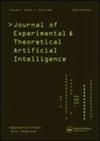基于深度学习的深度森林模型的COVID-19患者早期诊断
IF 1.7
4区 计算机科学
Q3 COMPUTER SCIENCE, ARTIFICIAL INTELLIGENCE
Journal of Experimental & Theoretical Artificial Intelligence
Pub Date : 2022-01-06
DOI:10.1080/0952813X.2021.2021300
引用次数: 4
摘要
冠状病毒病-19 (COVID-19)在全球范围内迅速蔓延。发现在COVID-19疾病早期,逆转录聚合酶链反应(RT-PCR)检测灵敏度较低。因此,需要高效的模型来进行COVID-19感染患者的早期检测。COVID-19感染患者的胸部x线(CXR)图像显示一些双侧改变。本文提出了一种基于深度迁移学习和深度森林的模型来诊断CXR图像中的COVID-19感染。首先,使用众所周知的深度迁移学习模型(即ResNet101)提取x射线图像的特征,与深度卷积神经网络(CNN)相比,该模型不需要调整许多参数。然后,利用深森林模型对COVID-19感染患者进行预测。深度森林是基于集成学习的,需要少量的超参数。此外,所提出的模型在一个多类数据集上进行训练,该数据集包含四种不同的类别,分别是COVID-19(+)、肺炎、结核病和健康患者。将深度迁移学习模型与基于深度森林的竞争模型进行了比较。结果表明,该模型能有效诊断COVID-19感染,准确率达99.4%。本文章由计算机程序翻译,如有差异,请以英文原文为准。
Early diagnosis of COVID-19 patients using deep learning-based deep forest model
ABSTRACT Coronavirus disease-19 (COVID-19) has rapidly spread all over the world. It is found that the low sensitivity of reverse transcription-polymerase chain reaction (RT-PCR) examinations during the early stage of COVID-19 disease. Thus, efficient models are desirable for early-stage testing of COVID-19 infected patients. Chest X-ray (CXR) images of COVID-19 infected patients have shown some bilateral changes. In this paper, deep transfer learning and a deep forest-based model are proposed to diagnose COVID-19 infection from CXR images. Initially, features of X-ray images are extracted using the well-known deep transfer learning model (i.e., ResNet101), which does not require tuning many parameters compared to the deep convolutional neural network (CNN). After that, the deep forest model is utilised to predict COVID-19 infected patients. The deep forest is based upon ensemble learning and requires a small number of hyper-parameters. Additionally, the proposed model is trained on a multi-class dataset that contains four different classes as COVID-19 (+), pneumonia, tuberculosis, and healthy patients. The comparisons are drawn among the proposed deep transfer learning and deep forest-based models, the competitive models. The obtained results show that the proposed model effectively diagnoses COVID-19 infection with an accuracy of 99.4%.
求助全文
通过发布文献求助,成功后即可免费获取论文全文。
去求助
来源期刊
CiteScore
6.10
自引率
4.50%
发文量
89
审稿时长
>12 weeks
期刊介绍:
Journal of Experimental & Theoretical Artificial Intelligence (JETAI) is a world leading journal dedicated to publishing high quality, rigorously reviewed, original papers in artificial intelligence (AI) research.
The journal features work in all subfields of AI research and accepts both theoretical and applied research. Topics covered include, but are not limited to, the following:
• cognitive science
• games
• learning
• knowledge representation
• memory and neural system modelling
• perception
• problem-solving

 求助内容:
求助内容: 应助结果提醒方式:
应助结果提醒方式:


